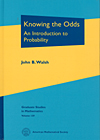- About MAA
- Membership
- MAA Publications
- Periodicals
- Blogs
- MAA Book Series
- MAA Press (an imprint of the AMS)
- MAA Notes
- MAA Reviews
- Mathematical Communication
- Information for Libraries
- Author Resources
- Advertise with MAA
- Meetings
- Competitions
- Programs
- Communities
- MAA Sections
- SIGMAA
- MAA Connect
- Students
- MAA Awards
- Awards Booklets
- Writing Awards
- Teaching Awards
- Service Awards
- Research Awards
- Lecture Awards
- Putnam Competition Individual and Team Winners
- D. E. Shaw Group AMC 8 Awards & Certificates
- Maryam Mirzakhani AMC 10 A Awards & Certificates
- Two Sigma AMC 10 B Awards & Certificates
- Jane Street AMC 12 A Awards & Certificates
- Akamai AMC 12 B Awards & Certificates
- High School Teachers
- News
You are here
Knowing the Odds: An Introduction to Probability

Publisher:
American Mathematical Society
Publication Date:
2012
Number of Pages:
421
Format:
Hardcover
Series:
Graduate Studies in Mathematics 139
Price:
75.00
ISBN:
9780821885321
Category:
Textbook
The Basic Library List Committee suggests that undergraduate mathematics libraries consider this book for acquisition.
[Reviewed by , on ]
Robert W. Hayden
11/1/2012
The title of this book suggests that it might be another chatty book on probability for the general reader, but a closer look reveals that it is in a series of Graduate Studies in Mathematics. That too is a bit misleading — it is in fact a textbook for those who are now (or will soon be) graduate students in mathematics — not a treatise for those on the fringes of research.
Ideally the readers of this book would have successfully made the transition from homework that asks them to “Find” to homework that asks them to “Prove”. In some undergraduate programs, that happens in whatever upper-division mathematics course a student happens to take first. In other programs, a single course is chosen from the usual suspects for this initiation (linear algebra serves this role in at least one college), while in still others there is an entire course devoted to this initiation.
The relevance of this digression to the book at hand is that, where initiation is by random selection, this text might be a better-than-average choice for that first course. While it does begin with a formal definition of sigma-algebras, the author also provides generous doses of humor and enthusiasm. Proofs often include a discussion of strategy before plunging in. Many connections are made with topics in real analysis. While hardly an applied text, there are many references to both current applications and the historical applications that gave rise to the topics covered. Homework problems are varied and interesting, and hints are provided for many. (As with most “Prove” texts, no solutions are supplied.) All in all, this text ranks very high in reader engagement compared to other texts in abstract mathematics, and so makes an excellent textbook for those at or a bit beyond the transition to proving everything.
The first half of the book covers standard topics and culminates with a proof of the Central Limit Theorem. Just what is considered a proof (or even what is considered the theorem) varies widely; Walsh proves a version due to Lyapounov which does not assume equal variances in the random variables summed, and defines the convergence as “convergence in distribution”. Here as elsewhere the author gives an intuitive sense of why the theorem might well be true, though he sometimes overstates practical applicability. In this part of the text there are many semi-applied problems about games and puzzles which help make the abstract ideas concrete.
The second half of the book covers what we might call “special topics”: Markov chains, random walks, conditional expectations, discrete parameter martingales, and Brownian motion. Here applications to finance stand out, particularly the discussion of the Black-Scholes Model. As elsewhere, the discussion goes far enough to convince you there are applications, but not far enough that you could actually accomplish much in the way of application. In fact, in this part of the book the problems are generally purely mathematical.
I recommend this book for consideration to anyone teaching a graduate probability course. It is a fine book, but your choice may depend on whether you like the choice of special topics. The ideal audience for this text might be mathematics majors (including faculty) curious about the mathematics of probability and its relation to real analysis. It might be a hard sell to students in other majors. As a result the only misgiving about the text is that many of us must teach probability to a mixed audience of majors and non-majors, and the latter group may long for fewer proofs and more detailed guidance to applications.
After a few years in industry, Robert W. Hayden (bob@statland.org) taught mathematics at colleges and universities for 32 years and statistics for 20 years. In 2005 he retired from full-time classroom work. He now teaches statistics online at statistics.com and does summer workshops for high school teachers of Advanced Placement Statistics. He contributed the chapter on evaluating introductory statistics textbooks to the MAA's Teaching Statistics.
See the table of contents in pdf format.
- Log in to post comments




